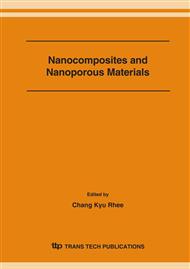p.247
p.251
p.255
p.259
p.263
p.267
p.271
p.275
p.279
Synthesis Of Ti50Ni50 Alloy Nanopowders Synthesized by Modified Levitational Gas Condensation Method
Abstract:
The stoichiometric Ti50Ni50 alloy nanopowders were synthesized by levitational gas condensation (LGC) using micron powder feeding system and their particulate properties were investigated by X-ray diffraction (XRD), transmission electron microscopy (TEM) and Brunauer- -Emmett-Teller (BET) method. The starting Ti and Ni micron powders ∼ 150μm were incorporated into the micron powder feeding system. The ingot type of Ti-Ni alloy was used as a seed material for levitation and evaporation reactions. The collected powders were finally passivated by oxidation. The x-ray diffraction experiments have shown that the synthesized powders were completely alloyed with 50Ti and 50Ni in at.% and comprised of two different cubic and monoclinic crystalline phases. The TEM results showed that the produced powders were a very fine and uniform with the spherical particle size of 18 to 32 nm. The typical thickness of passivated oxide layer on the particle surface was about 2 to 3 nm. The specific surface area of the Ti-Ni alloy nanopowders was 54.8 m2/g based on a BET method.
Info:
Periodical:
Pages:
263-266
Citation:
Online since:
January 2007
Authors:
Keywords:
Price:
Сopyright:
© 2007 Trans Tech Publications Ltd. All Rights Reserved
Share:
Citation:


